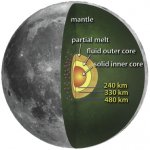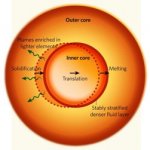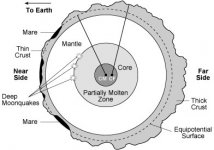A complete sentence must include a verb and make complete sense standing on its own.Regarding your views on sentence structure, it's not a rule, merely a general guideline.
It is unarguable that "After supper." makes no sense standing on its own!
A sentence that does not contain a verb is called a nominal sentence. These are relatively uncommon in the English language.
"What a great day today!" is a nominal sentence since it does not contain a verb. It's complete form is "What a great day it is today!" where "is" provides the verb.
Pete's so-called "sentence" can't even be placed in the nominal category!
and the question mark??? 🙂
umm, I certainly didn't call it a sentence. It is however a communication.
umm, I certainly didn't call it a sentence. It is however a communication.
Last edited:
The Moon is known to have a dense metallic core comprising of a small solid inner core surrounded by a liquid core.The Moon is constantly facing the same side towards Earth, because of an imbalanced iron core that makes it function somewhat like a giant compass needle.
It is thought that in the distant past rotational dynamics produced a "dynamo effect" which may have produced strong magnetic fields, evidence of which are recorded in lunar rock samples.
I can't find any reference to the Moon having an imbalanced or unbalanced iron core.
However, I have found this, dated June 2021: Is Earth’s core lopsided? Strange goings-on in our planet’s interior. | Berkeley News
For reasons unknown, Earth’s solid-iron inner core is growing faster on one side than the other, and it has been ever since it started to freeze out from molten iron more than half a billion years ago, according to a new study by seismologists at the University of California, Berkeley.
Attachments
Don't you mean the LARGE question mark? 😀and the question mark??? 🙂
make complete sense standing on its own.
By that part of the definition there are some entire books that fail to contain a single sentence.
Most sentences I know would require an additional sentence or a broader context to give proper meaning.
I think you'd enjoy a classic Norwegian tale called "God dag, mann. - Økseskaft!"
(Good day, man. - Axehandle!)
Edit:
Moon model - An offset core. - NASA Technical Reports Server (NTRS)
Last edited:
Let's hope you are not the first human to communicate with an extraterrestial!I certainly didn't call it a sentence. It is however a communication.

Apparently I'm way too late. 🙂
as far as the non sentence goes, just add your own connotation. It is after all personal to you, right? 😛
as far as the non sentence goes, just add your own connotation. It is after all personal to you, right? 😛
Then those books, by definition, are badly written. 😉By that part of the definition there are some entire books that fail to contain a single sentence.
I've looked at your link: Moon model - An offset core. - NASA Technical Reports Server (NTRS)
Searching for "offset core of moon" takes me to this link: NASA's CosmosIn the proposed model the Moon has a core whose center is offset from the center of the outside spheroid towards the earth. Such a core will be formed if the Moon were entirely molten at some time in its past, and on solidification was synchronous with the earth.
It appears that the Moon's centre of mass is offset by 2 kilometres from its geometrical centre.
So far, however, I can't find how this correlates with the fact that "The Moon is constantly facing the same side towards Earth."
Can you help come up with that correlation?
Attachments
Last edited:
I'll mix in fluid dynamics, and simplify.
A vast meteor strikes a massive lump of liquid rock. Fast forward to the after effects of the impact: Cue two molten orbs with spin, the heavier elements slowly sink to the individual centers while the lighter elements are supplanted towards the surfaces, the heavier elements have a stronger pull towards the other orb because of magnetic fields being strengthened by the internal friction heat. Weight and magnetic fields of the heavier elements attract and fight against the spin that threatens to distance the two orbs. The offset of the center slowly cause a stronger braking effect and eventually a lock in spin when the smaller body solidifies more rapidly than the larger.
Edit:
Like holding a bowl filled with water and rocks, start spinning around and the lighter water will move towards the edge of the bowl and perhaps even spill. While the heavier rocks are impacted more by gravity than spin.
So on the moon the iron core will be closer to the centre of gravity and the lighter rocks will move towards the outer edge of the spin.
A vast meteor strikes a massive lump of liquid rock. Fast forward to the after effects of the impact: Cue two molten orbs with spin, the heavier elements slowly sink to the individual centers while the lighter elements are supplanted towards the surfaces, the heavier elements have a stronger pull towards the other orb because of magnetic fields being strengthened by the internal friction heat. Weight and magnetic fields of the heavier elements attract and fight against the spin that threatens to distance the two orbs. The offset of the center slowly cause a stronger braking effect and eventually a lock in spin when the smaller body solidifies more rapidly than the larger.
Edit:
Like holding a bowl filled with water and rocks, start spinning around and the lighter water will move towards the edge of the bowl and perhaps even spill. While the heavier rocks are impacted more by gravity than spin.
So on the moon the iron core will be closer to the centre of gravity and the lighter rocks will move towards the outer edge of the spin.
Last edited:
I was really hoping for a published reference, KaffiMann.
Am I to take it that you believe that the Moon is not spinning?"The offset of the center slowly cause a stronger braking effect and eventually a lock in spin when the smaller body solidifies more rapidly than the larger."
Wouldn't surpise me if a tidally locked Moon goes a bit, er, egg-shaped... 🙂
The classic culprit is Jupiter's moon Io. All sorts of things going on there, including an elliptical orbit that whacks it with heating tidal forces:
Io (moon) - Wikipedia
By some weird coincidence, I was testing my knowledge of the 31 "Mysterious Moons of the Solar System" on this monstrously clickbait but interesting site:
Mysterious moons of our solar system
Io and the Moon came first and second. But all the usual suspects are in there.
The classic culprit is Jupiter's moon Io. All sorts of things going on there, including an elliptical orbit that whacks it with heating tidal forces:
Io (moon) - Wikipedia
By some weird coincidence, I was testing my knowledge of the 31 "Mysterious Moons of the Solar System" on this monstrously clickbait but interesting site:
Mysterious moons of our solar system
Io and the Moon came first and second. But all the usual suspects are in there.
To put that into perspective, the radius of the Moon is approximately 1737 kilometres.It appears that the Moon's centre of mass is offset by 2 kilometres from its geometrical centre.
So a 2 km offset translates to only 0.12 % compared to the Moon's radius.
You would have to wait until they manage to find enough funds to do a thorough dissection. Fact as we kow it so far: gravitational center is offset from geographical center. The end.I was really hoping for a published reference, KaffiMann.
Am I to take it that you believe that the Moon is not spinning?
I'll give you the boring answer: Depends where you stand. 😀
Your post did, at first, appear personal to me since it was my post which preceded yours.It is after all personal to you, right? 😛
I reconsidered that in my edit.
However, it became more personal to me when KaffiMan, bless his little Norwegian socks (or lack of), decided to teach me the rules of English grammar! 😱
All is now hopefully in the past, and I am now in a more copacetic mood! 😀
If only we could construct a beginning and a middle! 😀The end.
it became more personal to me when KaffiMan, bless his little Norwegian socks (or lack of), decided to teach me the rules of English grammar!
Rules are ment to be broken at least once
I can convince a broken twig to stick!
Edit:
If only we could construct a beginning and a middle! 😀
Just re-run the simulation.
It's all in your head.If only we could construct a beginning and a middle! 😀

I'll give you the boring answer: Depends where you stand. 😀
Does it now - I don't think so. A body is either spinning around its own axis or not - it doesn't matter from where you observe that. An other case is if a human can detect/see it or not.
//
- Status
- Not open for further replies.
- Home
- Member Areas
- The Lounge
- What is the Universe expanding into..


